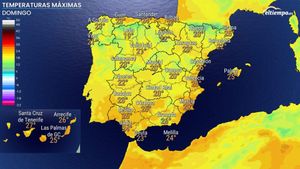Severe weather events, characterized by ferocious storms and dense smoke, have significantly impacted transportation and visibility across Western Australia, raising concerns over the resilience of infrastructure.
Recent occurrences highlight the effects of ex-Tropical Cyclone Zelia, which wreaked havoc earlier this month, delivering winds up to 290 kilometers per hour and dropping over 450 millimeters of rain. This resulted in widespread flooding, particularly affecting the Great Northern Highway, which is pivotal for transporting goods across the state. The highway, linking Perth to the northern port of Wyndham, was closed for repairs due to the storm's aftermath, temporarily disrupting supply chains.
According to Main Roads WA, the affected section of the Great Northern Highway has now reopened, albeit under traffic management, after temporary repairs were hastily made to mitigate the logistical disruptions. Dr. Elizabeth Jackson, an associate professor of supply chain management at Curtin University, emphasizes the growing frequency and intensity of such weather events. 'These kinds of weather events are becoming more common,' she reiterated, calling for immediate and long-term infrastructure investments to fortify WA's transport networks.
Dr. Jackson's insights resonate particularly well with the agricultural sector, which relies on these transport routes for timely delivery of goods. Given these challenges, she insists the government must act swiftly to revitalize its infrastructure to withstand climate variations. 'The regions need a lot more attention, particularly when it involves freight and logistics,' she stated, advocating for increased investments to safeguard economic viability.
Adding to the region's troubles, dense smoke stemming from bushfires around Manjimup and Collie is posing immediate hazards to motorists, particularly across Perth’s northern suburbs. The Parks and Wildlife Service issued warnings about poor visibility, urging caution as smoke extended from the eastern winds before shifting westerly. Various locations including Jurien Bay and Walpole are affected, based on the current weather patterns.
Motorists are advised to exercise heightened caution, including driving with headlights on and pulling over if visibility diminishes. The authorities also provide guidance for susceptible individuals, like those with respiratory issues, advising them to seek immediate advice from healthcare professionals if necessary. This situation ties back to the urgent requirement for strategies to manage the intertwined aspects of transport logistics and emergency responses.
The interplay between these weather phenomena is evident as authorities grapple with smoke-related incidents on major highways, compounding the somewhat recurring disruptions faced by the transport industry. Recent traffic reports indicated congestion due to minor incidents on the Mitchell and Kwinana Freeways, underscoring the overall strain on road networks.
With each severe weather episode, the discussion concerning the adequacy of existing infrastructure resurfaces. Dr. Jackson emphasized, 'It is embarrassing, it does need work and the regions are forgotten.' These sentiments capture the core frustrations of the agricultural and transport sectors which are increasingly feeling the pressure from unpredictable weather conditions.
History supports her assessment, as exemplified by the havoc wreaked by ex-Tropical Cyclone Ellie earlier this year, where over 800 millimeters of rain left parts of the Kimberley region isolated. The Fitzroy River Bridge and sections of the Great Northern Highway were severely damaged, accentuating the vulnerabilities tied to infrastructure resilience across WA.
Authorities managed to construct and open a new bridge on the Fitzroy River earlier than expected, but Dr. Jackson notes this is only part of broader solutions needed. Strategic development is required to adapt to the rising frequency of weather-related crises, especially since mere infrastructure repairs won't suffice. 'There are solutions coming but we need to look at what we are doing now,' she stated, highlighting the need for proactive measures.
Despite efforts toward upgrading infrastructure over time, history has shown the limitations of existing frameworks when faced with increasingly severe weather events. Legislative, financial, and logistical barriers also complicate swift adaptations, often necessitating extensive bureaucratic maneuverings for permits and approvals, especially for heavy transport reroutes during emergency closures.
Dr. Jackson’s appeal for immediate responses resonates as residents and businesses alike absorbed the brunt of disruptions during cyclone Zelia's aftermath. 'What are they going to do about it?' she asked, culminating the urgent need for action.
Going forward, it would take cohesive action from both state authorities and the transport sector to genuinely prioritize and redevelop strategies to mitigate the future risks posed by climate change on Western Australia's transport networks.



